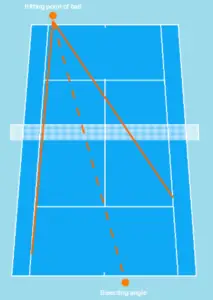Tennis tactics basics
Tennis tactics for beginners
Tennis tactics for beginners
With every tennis stroke you make a tactical decision – where do I return the tennis ball? Do I play the ball safely into the court or do I increase the pace to get the opponent going? Do I attack the net or stay behind? There are a variety of ways to win the point.
Many tennis players have developed a first-class technique, but their tactical understanding is still at beginner level. Therefore, initial tactical fundamentals tennis beginners should learn as they learn tennis technique.
Below we explain the most important tactical tennis basics to tennis beginners so that you don’t lose unnecessary tennis games.
1. Why are tactics so important?
Tactics are crucial on the tennis court to win tennis matches. Every point is won by an own winner, a tennis stroke that is not reachable for the opponent, by a forced error or non-forced errors.
Most tennis points are won by forced errors and not by Winners. This may come as a surprise, since in most videos of tennis pros, points are often finished with a Winner, and in training, the focus is often on hitting Winners.
Below we describe the 5 basic tactical moves:
a) Safety
The easiest way to lose the point is to produce an unforced error, where the tennis ball is played into the net or out without distress. To prevent this, the safety of one’s tennis strokes should be increased.
This includes, for example, playing the ball higher over the net to avoid a mistake and to have more time to position oneself correctly in the court again.
b) Length
In addition, the length of one’s shots is crucial. The longer the ball is played, the more difficult it is for the opponent to attack the net. Therefore, tennis beginners should try to play at least always behind the T-line of the tennis court.
At the same time, it is difficult for tennis players who stand far behind the baseline to run into a stop ball.
c) Direction
Many tennis players are very confident with the ball, especially from a standing position, and make almost no mistakes. With a change of direction, the opponent is made to run and can be forced to make mistakes from the run.
At the same time the opponent is challenged more conditionally, so that especially in sunny temperatures the opponent consumes a lot of energy. Both at tennis tournaments and medal matches we often see players with conditional problems.
d) Speed
We often see that the speed of tennis strokes is overrated. People hit the tennis ball harder and harder and use a lot of energy in vain.
The art is to increase the speed when in a promising position, but not to continuously hit the tennis ball over the net at full speed.
e) Variability
Advanced tennis players play much more variably and have more tennis strokes in their repertoire.
It is important to follow the basic tactical sequence of safety, length, direction, speed and variability. If there is no safety, changes of direction or speed will be difficult or impossible.
Therefore, assess realistically on which tactical level of the basic moves you are, so that you make the right tactical decision in the different game situations.
2. Positioning - movement without tennis ball
When asked where tennis players should move after hitting a tennis ball, we often hear to the center of the court. However, this is not correct.
It is correct to position oneself depending on the possible trajectories of the opponent’s tennis ball. This means that we move to the bisector of the angle.
In the following graphic it becomes clear that the dashed bisector is not the same as the center of the court, but that you should move further to the right.

3. Know your tennis strengths and weaknesses
Every tennis player has strokes that are more routine than other strokes. With tennis beginners, the forehand is often a little stronger than the backhand.
It is important that every tennis player is aware of his or her own strengths and weaknesses, because only then can they be played to one’s own advantage. Below are three examples:
a) Forehand is better than backhand
If your forehand is stronger than your backhand, you should try to play more forehands than backhands.
For example, when positioning yourself without the ball, you can not move exactly to the bisector of the angle, but position yourself a little more to the backhand side, so that the forehand side is offered to the opponents and played there more often.
At the same time, the backhand side can be circulated more easily and every ball can be played with the forehand, especially from the radius of the angle bisector.
b) Solid groundstrokes, but weak volley
If the tennis groundstrokes are clearly better than the volleys, you should try to play as few volleys as possible.
If the opponent gets too short or plays a stop ball, you are forced to advance to the net, but there is a possibility to play the last groundstroke before a potential volley with more risk – change of direction or increased speed – so that the volley is avoided or – if the opponent still returns the ball – becomes very easy.
c) Strong first serve, but weak second serve
If the first serve is very solid, but the second serve often leads to a double fault, you should try to play as few second serves as possible.
Therefore, try to slow down the first serve a bit to increase the service ratio and avoid playing the second serve. This way the strong first serve may lose a little of its power, but double faults are avoided.
As you can see from the examples, your strengths and weaknesses can be used consciously on the tennis court and especially in tennis tournaments and medal matches in order to be successful.
4. How are the form of the day and the external conditions?
Everybody knows it: some days everything goes well on the tennis court and some days nothing goes well.
It is important to recognize early on, do I hit the ball cleanly today or am I often too late on the ball already during warm-up play and do not have the necessary feel for the ball.
In addition to your own form on the day, the external conditions also play a role. Is it very windy outside? Do the balls bounce unusually high due to days without rain?
One’s own tactics should be adapted accordingly, so that in unfavorable conditions one plays more for safety and to avoid mistakes, whereas in ideal conditions one can increase speed and variability.
5. Summary and conclusion
Tactical decisions are made with every tennis stroke. Well-chosen decisions can put you in an advantageous position for the next shot – disadvantageous ones logically also put you in trouble.
For tennis beginners, it is important to be aware of the tactical basics of tennis and to pay attention to them early on so that potential weaknesses can be compensated for.
At the same time, every tennis player has a good or bad day, just as the external conditions are sometimes more advantageous or disadvantageous. To recognize this in every match and to react accordingly is the great art.
We wish you a lot of fun trying out the first tactical basics on the tennis court.

